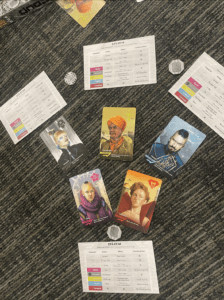Coup
Coup is a social deduction card game designed by Rikki Tahta and published by Indie Boards & Cards and La Mame Games. 2-6 players start the game with two hidden roles. Through deduction based on probability, actions, and social cues, players decipher each others’ roles while simultaneously eliminating one another.

Formal Elements + Types of Fun
- Deception: Due to the existence of hidden roles, players are encouraged to lie and manipulate each other to gain the upper hand. Therefore, players must make a decision to tell the truth or bluff while remaining observant of other players’ tells and behaviors. This decision inherently involves expression since the most common action a player takes could depend on if they are a good or bad liar.
- Elimination: Players get eliminated from the game when both their roles are revealed. Elimination builds risk and tension since players are more likely to take a risk when they are in danger of being eliminated. Elimination also creates an incentive to stay in the game for as long as possible since some players might find satisfaction in being eliminated later on in the game even if they don’t win.
- Last Man Standing: The objective of Coup is to be the last player standing. Although alliances may form to take out the player with the greatest advantage, Coup ultimately breeds competition since the outcome is always one winner. Winning Coup is especially fun since it demonstrates the mastery of game strategy, social perception, and social deception.
- Constant Player Interaction: On every turn, players constantly interact with one another and resources (coins) through actions and counteractions (i.e. stealing, assassinations, blocks). As a result, players are engaged and observant even if it is not their turn, in hopes to gain information about other players’ roles. Some actions (stealing, assassinations) allow players to target one another which builds drama. These aesthetics and emotional sensations all contribute to fellowship— players take revenge, suspect, laugh, betray, and get to know each other better.

Graphic Design
The visually appealing illustrations on the cards and tokens make the gameplay more pleasing and also enhance Coup’s theme of a somewhat dystopian society. The instruction table with roles, actions, and counteractions also makes the rules clear by always providing a clear reference for players to look at.
Competition + Improvement
As a social deception game, Coup competes with Among Us, Spyfall, and Mafia. However, Coup differentiates itself by having no “good guy” or “bad guy.” There are is no team vs. team in Coup (alliances aside). Players can attack any other player at any time, and these interactions of betrayal makes the game fun by leaving an emotional impact on the players as well as by adding elements of surprise and suspense.
To increase replayability, new roles and actions can be added to keep the game interesting for returning players; this will bring new opportunities for strategic play. Rules can also be modified. For example, imagine if each Duke can only block up to 2 foreign aids in one full round.



